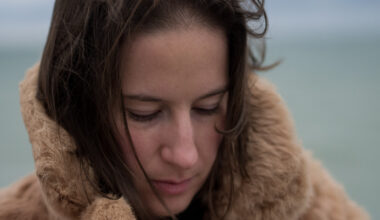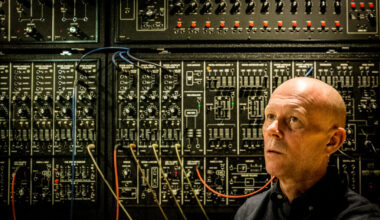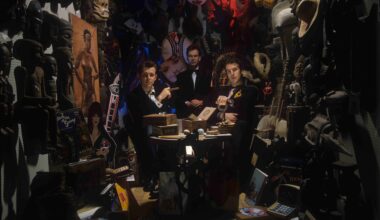How do you make music from shifting tectonic plates? We ask Stuart Hyatt, whose latest Field Works album redefines the meaning of rock music

Back in the spring of 2020, scientists around the world detected an unusual decline in seismic activity. Nothing shakes up a seismologist like a good vibration – or lack thereof – and a paper published several months later concluded that this was “the longest and most coherent global seismic noise reduction in recorded history”. Thanks to lockdown, the great quieting had occurred. Their conclusion? Humans make Earth rumble, and when we stop, it does too.
“We talk about the streets that were empty, that there were no planes in the sky,” says US-based musician and Field Works founder Stuart Hyatt. “But my question was – what did the Earth actually sound like?”
This is the subject of ‘Stations’, the 10th album in the Field Works series, which sees Hyatt collaborate with musicians and scientists to explore our sonic relationship with the natural environment. The previous nine albums have investigated everything from the echolocations of endangered bats to the acoustic resonance of a Texan cave.
“The whole Field Works experiment is about listening as a way of understanding, as a way of honouring, as a way of respecting, and ultimately protecting things that we feel are important,” Hyatt explains. Dressed in a twin-pocketed brown shirt, he looks as much a geologist as he does an electronic musician. Self-taught in both, it’s a tension which has so far been central to his practice.
“I feel like I missed out on being a scientist,” he admits, recounting an education that instead saw him train as a sculptor and architect. In fact, the first Field Works record, 2018’s ‘Pogue’s Run’, doubled as Hyatt’s master’s thesis. Years later, he quips that he is yet to design a building.
“The reason I called this project Field Works is that I liken it to the way a scientist goes into the field, gathers their data and brings it back to the lab to analyse,” he says. “That’s what I do with sound.”
On ‘Stations’, this “data” takes the form of various clicks, whirrs and crackles extracted from 10 monitoring stations in Alaska that Hyatt affectionately calls his “giant Arctic recording studio”. Using a custom MATLAB programming script, seismologist Debi Kilb then transposed the low-level frequencies into sonic material for the album’s percussive crust. All the while, I am resisting the urge to make a joke about rock music.
“It’s not unlike a big drum kit,” Hyatt enthuses. “Each individual ‘clack’ is not that interesting. It’s about how they’re all put together.”
Hyatt then had to assemble the humans, bringing in Janie Cowan (bass), Masayoshi Fujita (vibraphone), Qasim Naqvi (modular synth) and Brad Weber (beats, percussion) to create the swirling ambient foundations of the album.
“The whole idea was to have a human singalong with the Earth. It’s a corny proposition, but once you get over that, I think it’s a really beautiful one.”
On nine of the 10 tracks, this terrestrial duet is sung by American vocalist Hanna Benn. For the 10th, however, Hyatt called on another seasoned spirit guide.
“The human body and the Earth were experiencing this quieting in the same way, so who better to sing to this than Laraaji?” One email later and Hyatt was already unpacking a bundle of “oohs” and “aahs” from the renowned new ager, as well as recordings of his own laughter.
“I had no intention of using it,” Hyatt says, “but despite the terror of the last two years, there is a certain absurdity to it all.”
That ‘Stations’ concludes with the sound of Laraaji’s maniacal guffaws seems somehow fitting, yet it is only when Hyatt tells me how moved he was by Pink Floyd as a child that a comparison with the final moments of ‘The Dark Side Of The Moon’ begins to surface.
In their ambition, the Field Works projects are concept albums in the grand tradition, and for Hyatt, the connection lies in the sense of awe he experiences from both art and science.
“The scientists I talk to have that feeling, even with the nerdiest granular data point,” he explains. “It’s very similar to the idea of a religious experience, of the transcendent, of the supernatural. All of those things are what I look for in art too.”
The ‘Stations’ album is accompanied by a book that does not shy away from the science, as well as an exhibition at The Anchorage Museum, Alaska, where the project was first conceived. Each track has also been remixed, or “peer reviewed” as the liner notes put it, by musicians including Alva Noto, Afrodeutsche and Penelope Trappes.
Now the project is out in the world for real, is Hyatt any closer to understanding what Earth sounds like?
“The Earth, for better or for worse, includes us, our instruments and our voices,” he says. “With each project I’m trying to get a little deeper.”
Hyatt’s response probably deserves an ellipsis at the end of it. It is therefore no surprise to hear that Field Works 11 is already in motion.
“It’s all systems go,” he smiles, declining an invitation to elaborate. “All I can tell you is I am reading a lot about bioelectricity.”
‘Stations’ is out on Temporary Residence Ltd





